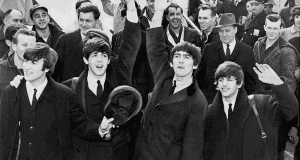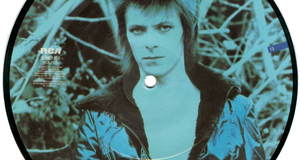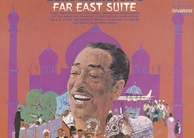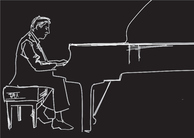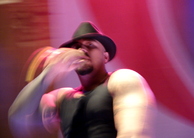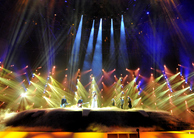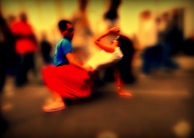Featured Article:Swagger and Soul: Analyzing the Music from Ocean's 11
By
2010, Vol. 2 No. 01 | pg. 1/1
IN THIS ARTICLE
KEYWORDS
One of the more overt dilemmas in the music of Ocean’s Eleven was the necessary need to reflect on the idea of old guard Las Vegas and the obvious modernity of the time in which the movie is set. It epitomizes classic Rat Pack versus online poker, Class versus Flash, gangsters versus gangstas. Because it is set in Las Vegas, nostalgia is impossible to avoid. Holmes and the music department take great care in choosing which side of Las Vegas they wish to portray in each given scene. It would be entirely inappropriate for this movie to beat the nostalgic side of Las Vegas into the audience’s head, but even more inappropriate for the film to ignore it. David Holmes is successful in his portrayal of a modern Las Vegas in that he melds the two worlds in his own compositions by mixing the sounds of a classic acoustic jazz combo with studio produced drum and bass grooves, but by also using external sources with the same variety, using clips from Elvis and Perry Como all the way to the current hip-hop group Handsome Boy Modeling School. Soderbergh’s numerous montages pay very close attention to timing, allowing the drum and bass style of Holmes to consistently groove without awkwardness. Always cool, Holmes’ capability to mix these styles and effectively define the mood of the scene allows a contemporary sense of style and class reminiscent of the Rat Pack of old. Ocean’s Eleven in Today’s ContextThe movie Ocean’s Eleven (2001) was a remake of the 1960 version of the same name, starring the original Rat Pack in Frank Sinatra, Dean Martin, Sammy David Jr., Joey Bishop and Peter Lawford. Naturally, the stars George Clooney, Brad Pitt, Matt Damon, Don Cheadle and Bernie Mac have enjoyed being referenced continually as a modern day Rat Pack, and rightfully so. Directed by the versatile Steven Soderbergh, the movie was very well received as well as an impressive commercial success at home and abroad.Encouraged, two sequels were made in the following years, Ocean’s Twelve (2004) and Ocean’s Thirteen (2007). While these were financial successes, the films were modestly reviewed and generally perceived to be excuses to get these gentlemen and ladies on screen with each other once more. Soderbergh’s versatility in style can be attributed in part to these films, which shows a lighter side to his work as opposed to such award winning films as Traffic (2000) and Erin Brokovich (2000). Originally a popular DJ in Belfast, Holmes began working with Soderbergh in 1998 with the film Out of Sight. After the success of Ocean’s Eleven in 2001, he returned do both sequels Ocean’s Twelve (2004) and Ocean’s Thirteen (2007). He was awarded the BMI Film Music award for his scores in the first two in 2002 and 2005. Visual and Musical Timing – Drum ‘n Bass Sound in Filmic TimeOne particular montage of chronological interest is when we meet Reuben, an old school casino owner played by Elliot Gould who’s recently been muscled out by the antagonist, fellow casino owner Terry Benedict, played by Andy Garcia. Danny Ocean (George Clooney) and Rusty (Brad Pitt) are trying to convince Reuben to join their heist, and as they are discussing the rest of their crew, we are introduced to some of the secondary characters. Soderbergh’s montages in the film work very well with the drum and bass style. Quick, active shots give way to occasional breaks in the action for a dialogue and with a vamp it’s easy to structure the music around these breaks without sounding out of place. As Rusty and Danny are excusing themselves to leave Reuben’s home, they off-handedly mention that they’ll be robbing Terry Benedict’s places. “What do you guys got against Terry Benedict,” Reuben asks, and an E-flat blues scale pattern is vamped behind the dialogue in the bass.
As the men size each other out, subtle additions to the orchestration help build the expectation as Reuben becomes interested. The vamp begins as he gets up from the table to walk towards Danny and Rusty. When the three are standing next to each other with Reuben facing the camera, the other two have their backs to the camera, making it seem as if our point of view is clearly on the side of Danny and Rusty. A shaker quietly sounds in rhythm as Reuben stops, and a pair of bongos adds to the rise as the conversation turns more forthright. The shot moves to the new characters but continues with the narration as if we’re still in the conversation. The ensemble now enters with horn hits and sax solo.
As they start to divulge their plan, they show us first Frank (Bernie Mac), happy as a clam in a car to Las Vegas, and then Turk and Virgil Malloy (Scott Caan and Casey Affleck, respectively). The vamp returns as we have a few moments of brief dialogue to explain the eclectic dynamic between the two brothers. As they start the race between the monster truck and the mini truck, the ensemble returns and the sax solo picks up energy. It’s cut short, however, when Turk, losing the race, crushes his brother’s radio controlled monster truck. There’s a moment of slapstick as the guitar takes the place of the tenor solo, mimicking a mocking “nyah-nyah” shout from a playground.
The scene switches to Livingston Dell, an electronics expert now working as a surveillance man. The ensemble drops to a crouch, adding mysterious doo-wah guitar sounds and a sneaky sax. It drops to almost nothing for his dialogue, subsequently making the transition to the end of the scene a long diminuendo.
Introducing the characters of this particular film is a lengthy process, one that could easily become tedious. Soderbergh’s strength in this film is his ability to define each character convincingly using small fragments of dialogue and visuals. The problem for him lies in the number amount of times he must achieve it, and the brief amount of time in which he must do it. Holmes succeeds in moving this process along without it becoming monotonous by shaping the scene dramatically, slow rise and slow fall, giving the audience a landing point for the next scene. Source Music in Ocean’s ElevenPopular music from outside the score helps to define the always-celebrated Las Vegas attitude. Following it throughout the film, it connects itself to specific ideas and scenes. Fragments of source music from earlier musical periods are used in the film as a contrast to Holmes’ ultra-modern sounding original music. The Source music helps draw attention to the idea of vintage Las Vegas, as many of the tracks are from the Golden Age of Vegas. One such striking instance is in a long aerial shot of the Las Vegas strip and various popular images of the city (28:21). In this part of the movie the characters are all about to be propositioned by Danny Ocean and this particular shot acts as an arrival to the setting of the rest of the movie. A Little Less Conversation by songwriter Mac David and recorded by Elvis Presley in 1968 accompanies this shot. It even provides a literal energy to the scene, with Elvis asking for, “a little less conversation, a little more action, please” Immediately following is Debussy’s Claire de Lune, which acts as background music for the crew’s first meeting and frames the sequence in an entirely different light than Elvis. Here it plays almost imperceptibly (almost absurdly) as Turk asks Saul if he gets to Utah much. “I think you’d do really well there.” Debussy returns only once more in the final Las Vegas scene (1:44:47), beginning as Tess leaves Terry Benedict and the men are returning back to their hideout. It begins with only piano in a fairly climactic phrase in the middle of the piece. As the van pulls into the garage, the rubato phrase swells and then dissipates with chromatically descending arpeggiations as the van turns out its lights and stops in darkness, resolving just as the scene turns black. The orchestra then takes over as the crew leaves the garage, moving from darkness into light. The Bellagio fountains are briefly seen in the distance and the scene moves to Tess as the phrase swells and increases tempo. She begins to run, searching for Danny as pairs of flutes and string duets play. “How long will you be,” she asks as a pair of oboes plays the theme and she watches the police car pull away. There is once more a shot of the Bellagio fountains, transitioning to the other members of the crew one by one. The piece begins its final phrases as Rusty looks around and walks away, fountain dancing in the background. One by one they all leave, and we’re left with one final shot of the fountain’s exploding as the chords die away. Within this last scene, Debussy’s score also marks the resolution of Tess and Danny’s relationship. Previous interactions between the two plays the Theme for Young Lovers, attributed to the Percy Faith Orchestra. The Debussy and Percy Faith tracks have similar orchestration, namely a lush string sound. Interestingly, the recording for Theme for Young Lovers is kept monophonic, as if it never left the record player. The theme is played twice, the first when Danny sees Tess for the first time in the restaurant (49:00), and the other much later in the film when Danny says goodbye to Tess (1:12:40). A fairly tense scene where the two fight over their past and present, specifically Terry, the music seems as if being played over the loudspeaker in the restaurant for mood music. The string sound floats overtop of the scene, never really with the dialogue, but its final cadences end the moment as Terry arrives, breaking up the conversation. In the same restaurant, Danny comes back to the same music to say goodbye. Later in the film we realize there are ulterior motives to Danny’s graceful adieu, but at this point in the film the two are still in conflict. The Theme for Young Lovers is played only the two times, both of which contain conflict, and in both instances the two seem like anything but lovers.
Musical and Filmic Representations of the Golden Age of Las Vegas, Elegance and The Rat PackThe film could easily become heavy handed with nostalgic sounds and images if there weren’t so much variety. Las Vegas is a place where one can be taken back in time with the slightest touch of reminiscence. Specifically three themes are touched with nostalgic codes, the large-scale images of Las Vegas, both on a personal level as well as the physical cityscape, Tess and Danny’s relationship and Saul. The fountain at the Bellagio is the most recognizable Las Vegas landmark today, yet its elegance is meant to take you back to the Golden Age where the women were glamorous like Marilyn Monroe and the men sophisticated like the Rat Pack. Helpful to its cause, the Bellagio’s list of musical/fountain performances include pieces like Sinatra’s Luck be a Lady or Pavarotti’s version of Vincenzo deCrescenzo’s Rondine al Nido from the opera La Rondine. Tess and Danny’s relationship is always softly accompanied by Percy Faith’s Theme for Young Lovers playing in the background. The fact that the actual recording they use is seemingly monophonic sounding gives the feeling it’s being played by a record player. You can imagine your grandparents or parents dancing slowly when they were once young lovers. The line itself lends to a yearning feeling as the first bar ascends to the ninth of the arpeggiated major chord before resolving, and also the repetitive third bar sweeping through as if one were thinking about the other. The theme then joined by its major third, as if the pair were reunited as it resolves. Saul’s character is perhaps the most interesting and less overt of the three images. We first meet him at the dog track in St. Petersburg, Florida. Dressed exactly as an old man at a dog track should be dressed, we hear Quincy Jones’ Blues in The Night a smooth big band sax section play a head motive that sneers with arrogance. The bends between the notes and the casual swing tempo perfectly describes the man who tells Rusty, “I saw you at the paddock before the second race outside the men’s room before I placed my bet. I saw you before you got up this morning.” The horns are bright and proud as they smear and and shake, and they swing as if they don’t have a care in the world. Saul is the oldest con man and the closest the group has to touching that infallible era of the Rat Pack. The other characters for the most part are portrayed by Holmes’ drum ‘n bass riffs, most drastically being Linus, who is introduced immediately after Saul, providing nice contrast. His Big Band arrogance translates over to the group, but his age and health occasionally comes up in the dialogue as being a problem. “Daniel, if you say that to me again, you will not wake up the following morning,” he says after Danny asks if he’s up for it. In the second scene with this music, Saul is shown getting ready to leave for his part of the mission, but he falters and sits on the bed looking rather unhealthy. This is in effect is supposed to make the viewers doubt in him and add a level of suspense as to whether or not the heist will be successful. Unfortunately for the director, the theme comes back again (1:06:10) and erases all doubt in Saul. We’re trusting of any man who can strut around with this song on his back. To us, Saul is the closest we can get to the actual Rat Pack while the other characters still have to earn our trust. Saul’s got swagger.
Transformations, Musical and OtherwiseEssentially these actors and this music had to achieve a transformation of character. Coming from whatever predispositions of distinguishing traits, the music and the personalities had to bridge the 40-year gap between the Rat Pack and the year 2001 and create a convincing modernization of the original film. As a remake, it must say something new, yet to ignore the original is a flawed way of thinking. The audience seeing this particular film is aware of the original film, regardless of whether or not they’ve seen it. The stigma attached to this particular film is that it is essentially a gangster movie shot in Las Vegas, and that the only difference between this one and all of the other iconic films shot in Las Vegas is that this one was happening in 2001. Soderbergh recognized this and knew that his characters had to undertake the task of becoming the Rat Pack. Musically speaking the task was identical. Holmes had to portray Sinatra Cool in a language that wasn’t dated. To do this, he had to assign personalities to the themes, such as Saul’s big band sound and Danny’s drum ‘n bass vamping. While the source music did the hard work in this transformation, mainly setting the stage for nostalgia, Holmes’ score successfully incorporates the instrumentation of the era and a feeling of Sinatra Cool. As the heist ends, timeless Claire de Lune plays in the full string orchestra as we see each of their faces one by one. Flash now meets class and sophistication and the Rat Pack lives on. Suggested Reading from Inquiries Journal
Inquiries Journal provides undergraduate and graduate students around the world a platform for the wide dissemination of academic work over a range of core disciplines. Representing the work of students from hundreds of institutions around the globe, Inquiries Journal's large database of academic articles is completely free. Learn more | Blog | Submit Latest in Music |














